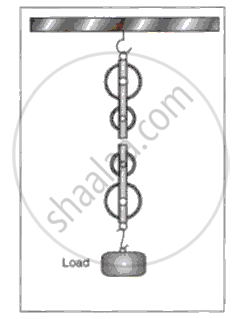Advertisements
Advertisements
प्रश्न
The ______ in the centre, the ______ on one side and the ______ on the other side make a lever of the second order.
उत्तर
The load in the centre, the fulcrum on one side and the effort on the other side make a lever of the second order.
संबंधित प्रश्न
When is work said to be done by a force?
Define the term ‘work input’ and ‘work output’ in relation to a machine.
State if the following statement is true or false. Correct the statement if it is false.
There are four types of simple machines.
Write the relation between mechanical advantage, velocity ratio and efficiency.
Fig show a system of four pulleys. The upper two pulleys are fixed and the lower two are movable.

(i) Draw a string around the pulleys. Also show the place and direction in which the effort is applied.
(ii) What is the velocity ratio of the system?
(iii) What is the mechanical advantage of the system?
(iv) What assumption do you make in arriving at your answer in part (iii)?
Define Mechanical advantage
Comment on the statement ‘The mechanical advantage of a machine is greater than 1’. Give an example of a lever mechanical advantage is:
(i) greater than 1.
(ii) Equal to 1.
What is the relationship between the mechanical advantage and the velocity ratio for:
(i) An ideal machine,
(ii) A practical machine.
Which machine will you use to do the following work? Write their type.
To hold a papad for roasting it.
Name the levers mentioned in the following passage. Identify the fulcrum, load, and effort of each and say which type of lever it is.
Ravi and Savita sit on a seesaw in a garden. In the meantime, a gardener is trimming trees in the garden. He puts the leaves and other garbage in the wheelbarrow. Later, Ravi gets thirsty and he buys lemon sherbet. The sherbet seller cuts the lemon and squeezes it using a lemon squeezer. He puts small pieces of ice in the glass with the help of the tongs.
